Introduction to Basic Electronic Components #10: Come Learn How to Build Basic Electronic Devices
Learning electronics can be sometimes daunting, even for me. Nobody really knows everything and depending on your field, learning new stuff can be fun or boring. I have been inconsistent on my blog and I know that a lot of persons must have noticed, - "I really have no excuse" - and all that I can say is that making unique but yet still interesting posts isn't easy and I kind of envy those who do. But that's no excuse and all I can do is to learn from them.
In the previous post, we learned all about multivibrators and I mentioned something about sharing my projects with you on steemit and also how I really needed to talk about some few components that I will use in my project, to help you understand all the electronic crap we might encounter.
In that same spirit, I will be talking about ICs in this post and more intently talk about the 555 timer IC.
But wait a minute, what IC are you talking about?
When I refer to IC, am not talking about Internal Combustion as regards to automobile, but rather am referring to Integrated Circuits
Integrated Circuits
Integrated circuits or rather IC have been in existence since 1946 and were developed jointly by Jack Kilby (1923–2005) and Robert Noyce (1927–1990). ICs are basically those small chips we see in almost every circuit board of our electronic devices like our phones, laptops and more.

A typical IC is just an electronic circuit consisting of several components like the resistors, capacitors, transistors, diodes etc. all integrated, stacked, stuffed or embedded and connected on a semiconductor chip usually silicon.
The aim or goal of doing this is to have a smaller, cheaper but yet faster circuit compared to those made from simple discrete components.
One thought that always comes to mind when thinking of ICs is: how can resistors, capacitor or transistors of up to thousands fit into a single chip?
The simple truth is that none of those components are actually fitted into a chip but are actually built/created on the semiconductor. The semiconductor is usually cut out into a small disc known as a wafer and the circuit or the components are then created on the chip by doping different areas of the chip to either turn them to an n-type or a p-type semiconductor using different methods like sputtering or vapor deposition.
The chips themselves are not the black packages we see on the printed circuit board of our appliances but are rather found inside in these packages. With a more closer look, a finished chip looks like a modern city with the components forming the city and the copper connections forming the streets.

Using an IC in this form would be difficult and much technical knowledge would be needed, hence the black packages or case. The black case not only makes an IC easy to use but also protects the chip from damage that could result from using it, and the small pins we see protruding from these packages link to the chip inside and is obviously what we use to connect the IC to a circuit board.
Using an IC
Anyone who ventures into building a device at one point or another ends up using an IC and knowing how to identify the pins on the IC is essential because each pin serves or function differently. The IC pins are usually numbered, and the difficult part is locating the first pin because all other pins are counted anti-clockwise around the chip from the first pin. And lucky for us, most manufacturers use either a notch or a dot to indicate the first pin.
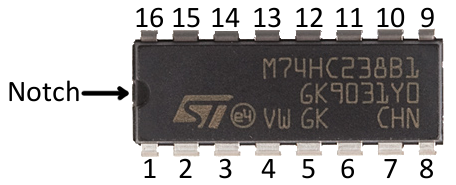
555 Timer IC
IC names are usually arbitrary and depend on the manufacturer. The name of an IC is usually found on its body and most a times you cant decipher the function of an IC from its name, and the next step to take would be to check the datasheet of the manufacturer or just google it.
The 555 timer IC as the name suggests is used as a timer and its main function is to give an output of changing state, for this reason, they also used in pulse generators, oscillators, and other timing circuits. On a 555 timer IC, the name you would see is NE555P or something similar. The function of each pin is illustrated in the figure below
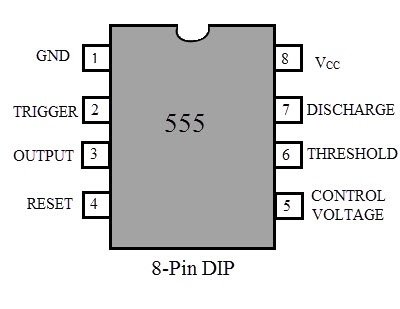
There is more detail to whats actually going on inside the 555 timer IC but in other to use the IC in building our circuits we don't need that much detail. Let's leave the logic behind the IC for another post.
I mentioned earlier that one of the benefits of an IC is that it miniaturizes complex circuit and that's true. By connecting the 555 timer circuit in a less complex way compared to what we did with the transistors last time we could build a multivibrator.
Recall I mentioned that multivibrators are circuits that give us the ability to create devices that implement two states, either "ON or OFF" and that there are three types of multivibrators namely; the monostable, the bistable and the astable, but with the 555 timer IC we can only implement two types which are the Astable multivibrator and the Monostable Multivibrator.
| Astable | Monostable |
|---|---|
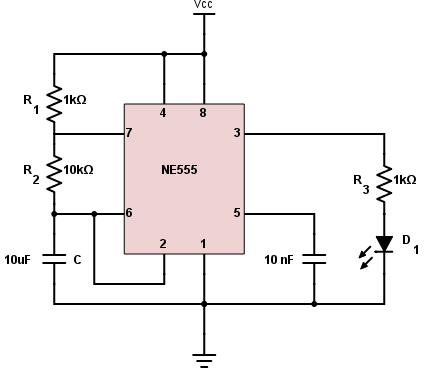 | 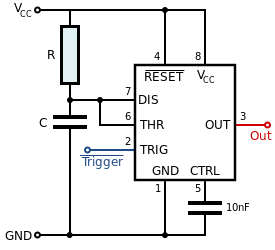 |
Constructing either a monostable or astable multivibrator using a 555 timer IC makes the job simpler as we will only be concerned with the resistors and capacitors we use at PIN6 and PIN7 because they determine the input to the IC. After determining the input values, PIN3 is where we tap the resulting output signal.
In the case of the Astable Multivibrator, the values of R1, R2, and C determine the ON time and OFF time of the IC. By changing their values we change the time constant RC, therefore changing output signal.
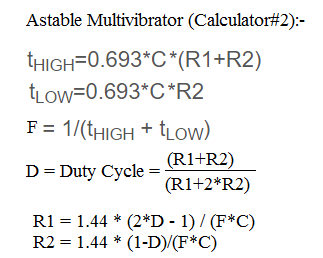
For different ICs the ON time and OFF time formulas may vary, probably because of the constant of proportionality. But this formula plays a major role when we put this circuits to a more practical application.
I know that no matter how much I keep talking, the beauty of this circuit will not be revealed until we all can see a little practical application and for this reason, in my next post I will introduce you to the project work I have been working on where I will use a 555 timer IC in an Astable mode to make an Electronic Piano
Reference:

Wow! While I am reading this article, it reminded the heydays of my education in Electrical and Electronic Engineering. Upvoted and Followed!
Am glad it brought back good memories
The legendary 555. I used it only once. Microcontrollers do all the magic now.
Yap that's true, but that's why it's Basic Electronic Components
Ah... the legendary "555". I wonder if it still in production :)